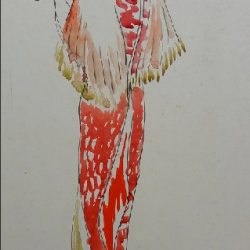Lost in Space: Len Lye’s unfinished science fiction Quicksilver
The Whangarei Art Museum is pleased to bring a selection of early works by renowned NZ artist, Len Lye. The exhibition showcases Len Lye’s early talent as a modern day renaissance artist accomplished in a variety of forms, giving insight to his experimental work as a filmmaker and ongoing exploration of the kinetic arts.
Len Lye was a unique artist who was able to transfer his ideas across a range of art disciplines. He is internationally renowned as a filmmaker and kinetic sculptor; however he was a true renaissance artist whose legacy extends across the visual arts, design and literature. His poetry was featured in the recent publication On the Thirteenth Stroke of Midnight: Surrealist Poetry in Britain edited by Michel Remy (Carcarnet Press, 2013).
Lye’s body of work documents his lifelong exploration of movement, leading to the development of some of the best kinetic art sculptures in the world. The exhibition showcases selected works from his early days as a young student in Wellington. These early studies would eventually form the background to his revelation and ambition to compose kinetic art works. On display are a collection of rare early works from the late 1910’s, generously on loan from the Len Lye family collection.
Lye moved to London in 1926, during a time when the Surrealist art movement had developed to influence not only the visual arts but also film, music, theatre and literature. In the early 1930’s Lye collaborated with painter John Aldridge and costume designer Basil Taylor from Sadler’s Wells Company towards the science fiction dance Quicksilver, to be made into a surrealist film. Although the film was never produced, Lye completed a portfolio of design drawings for the project. Included in the exhibition are a selection of fantastical costume and set design drawings from Quicksilver, depicting dream-like characters and landscapes both outlandish and wondrous.
Like many artists affected by World War II, Len Lye moved to New York in 1944, which was then becoming the new centre for modern art. Lye continued to work on various film projects and in 1957, was invited to submit work for the International Experimental Film Competition in Belgium, where he won Second Prize for his five minute black and white film Free Radicals. He developed the technique of scratching textures and shapes directly onto film, a medium he found that could express his early concept of composing pure movement.
His works continue to inspire audiences around the world – with two exhibitions from the Govett-Brewster Art Gallery and the Len Lye Foundation scheduled to open this year at the Drawing Center in New York and the Pulitzer Foundation for the Arts in St. Louis, USA.
Lost in Space exhibits together for the first time a rare viewpoint into Lye’s early developments as a multi-disciplined artist. The Whangarei Art Museum is grateful for the generous loans from the Len Lye family collection and NZ private collection, as well as the Museum of New Zealand Te Papa Tongarewa for the loan of their art work.












